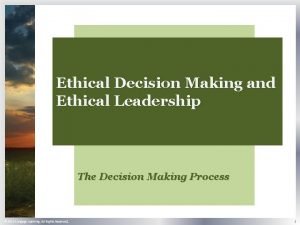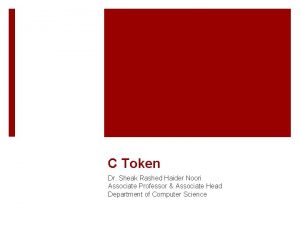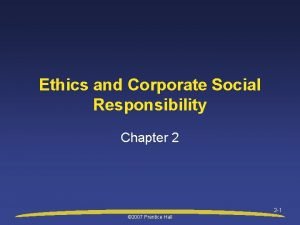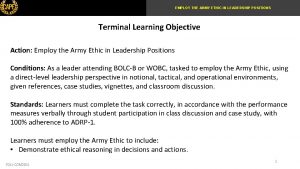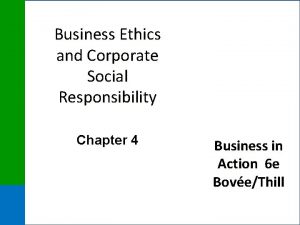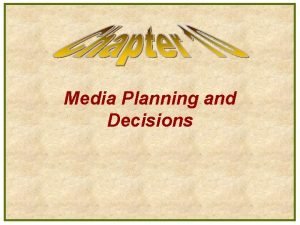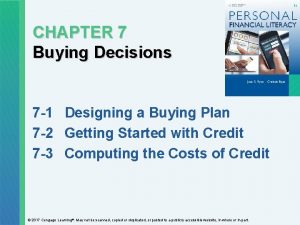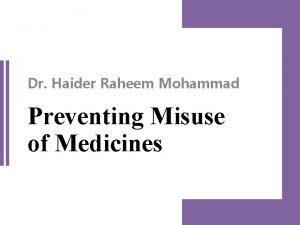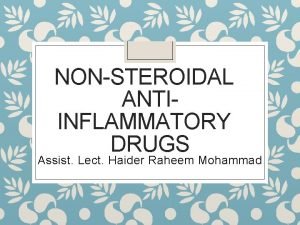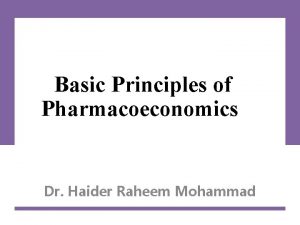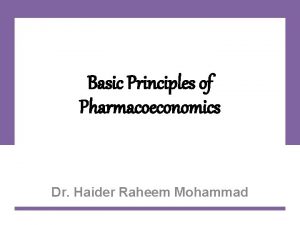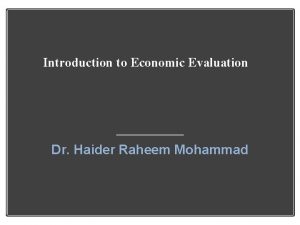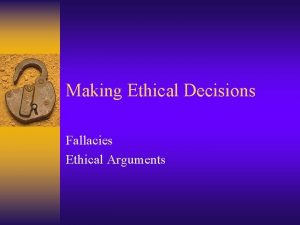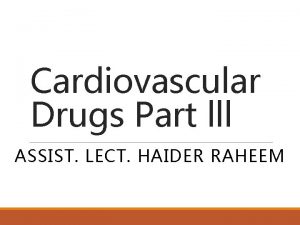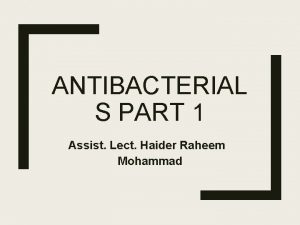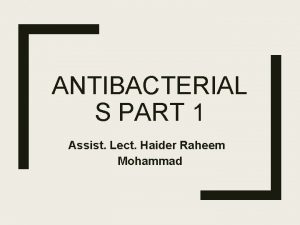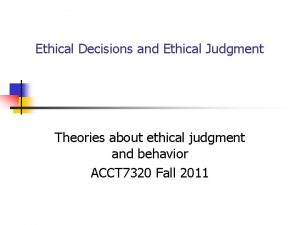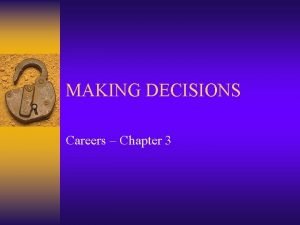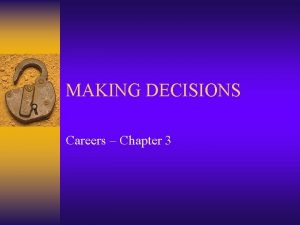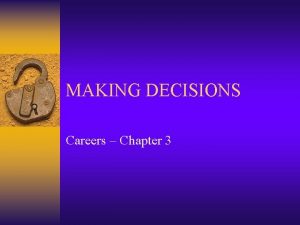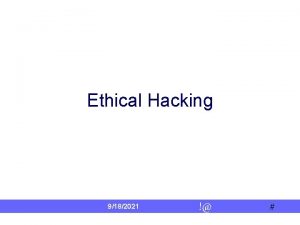Making ethical decisions Dr Haider Raheem Mohammad Why























- Slides: 23

Making ethical decisions Dr. Haider Raheem Mohammad

Why have a process for decision-making? • Before embarking on an exploration of professional decisionmaking, we should first ask whether it is different from any other decision making. In principle, probably not; we all have to make decisions all the time, every day: some trivial, some of great moment. But mostly we do not consciously follow a process to deal with them. • Moreover, decisions by pharmacists (and other healthcare professionals) are only part of an approach to solving problems. Some questions may not be in contention: for example the strength or dose of a medicine provided you can find an authoritative reference source; the wishes of the patient provided they are in front of you and able to respond.

Why have a process for decision-making? • It is more likely, however, that some decision-making must proceed in the face of uncertainty, particularly as to whether the chosen action is the ‘best or right’ course to take. • For example, would you always deny a patient access to pain-killing controlled drugs because her prescription is not legally valid? Would you always tell the police about suspected abuse of a sexually active young teenager? Conflicts can arise between the law or policy guidelines and best patient care, or between differing ethical goals such as telling the truth or respecting the patient’s wishes.

A good decision Systematic structure • The vast majority of us take decisions at great speed and with little reflection. Just as adults develop facility in taking decisions that we would not expect of a child, so experienced pharmacists frequently do not recognise that the process they use to take difficult decisions in practice has evolved from experience, the use of precedent, judgement and that old favourite ‘common sense’. However, it is possible to ‘slow down’ the process and break it up into stages and steps that, in reality, may have been addressed in a matter of minutes or less. An analysis of what you did and why you did it is of help the next time you are presented with a similar decision to make. • In any practice situation, a pharmacist should at least give some consideration to the key accountability question: What happens if something goes wrong? In retrospect, a systematic structure for decision making may provide some defence and insight into why you made the decision that you did. An analysis undertaken of what might go wrong before an event – a risk assessment – is even better.

Rational reasoning • A good professional decision should be underpinned by reason and rationality. To consider an absurd example, let us say that in your work as a pharmacist you decline to deal with patients whose surnames suggest they are of Scottish origin – Mc. Clean, Mc. Tavish, Mackenzie, for example. Your reason is that you don’t like the Scots! Clearly, this is not an acceptable reason for your decisions. Extend the scene to a refusal to deal with substance misusers, or homeless people, or alcoholics and at first sight we may assume that these are not decisions that could resist challenge, at least not in a healthcare context. • Limitations of conscience and belief in the inviolable right to life may constitute an adequate reason for some pharmacists not to take part. These are examples of ethical dilemmas: do you owe a greater duty of care to an addict or to other customers? Do you owe a greater obligation to your own conscience and protection of a possible fetus or to the teenage girl who may never have intended to risk pregnancy?

Value-based reasoning • One way of establishing that reasons are rational would be to base them on evidence. Pharmacists are very familiar with this approach. Patients may be provided with and understand that treatment A is better than B or even no treatment, based on empirical evidence, but nevertheless may choose to take another option based on what they value in their life.

Recorded decisions • Which brings us to the final feature of a good system – did you make a record? Unfortunately, pharmacists have traditionally been poor at recording their activities and decisions, but this is changing. • The RPSGB re-issued guidance on ‘recording interventions’ in April 2006. This guidance includes amongst the reasons for keeping a record: ‘to have an accurate record available for scrutiny where decisions could be challenged’ and amongst the occasions when this might be necessary mentions ‘Interventions that could potentially be queried or refuted’.

Identifying issues and resources • It is rarely possible to make a good decision without information. The information needed for a professional decision is likely to be clinical, legal or ethical – or all three. Generally speaking, pharmacists have little difficulty identifying clinical issues or in knowing where to look to find the information needed to clarify them. Identification of legal issues may also seem to be a fairly easy task for most pharmacists; they are well schooled in the detail of statutory law such as the Medicines Act and the Misuse of Drugs Act. • How do we identify an ethical issue? Pharmacists may find this more problematic. There may be several reasons for this. Many of our ethical sensibilities derive from our upbringing, our culture, our parents, friends and mentors, and we may already have fairly wellestablished views on what is right and wrong even before embarking on a pharmacy course.

Identifying issues and resources • We do not always recognise that we hold dear, our values, may not be the same for everyone. In our training as pharmacists, we will have been told about the profession’s Code of Ethics and that may have added to our awareness of the particular areas where ethical behaviour may be called into question. • Ethical issues frequently arise because of the inadequacy or inappropriateness of law. The classic example is usually given of the legally invalid prescription presented for a patient in urgent need of morphine for pain. Do you stick to the letter of the law and refuse to supply or do you break the law and supply because your highest obligation is to do good for the patient? This is an example of an ethical problem. An ethical dilemma is rather more rare in current pharmacy practice but arises when ‘two or more choices are morally justifiable, but only one is capable of being acted upon’.

Decision-making systems The ‘four-stage approach’ • • 1. Gather relevant facts 2. Prioritise and ascribe values 3. Generate options 4. Choose an option • To isolate legal and ethical issues from any clinical considerations, we use the following true scenario to illustrate application of our four-step process.

Decision-making systems The ‘four-stage approach’ • Two pharmacists were reprimanded by the Statutory Committee in 1991 following convictions for the supply to a 17 -year-old youth of sodium cyanide in one case and strychnine hydrochloride, potassium permanganate and glycerol in another. • Why were such supplies considered wrong? What thought processes should have been gone through in reaching a decision as to whether to supply? Pharmacists are permitted to supply all these substances from a pharmacy, so why were convictions as well as a reprimand given? Would it have been right to supply in other circumstances? If so, on what knowledge would you have based your decision?

Decision-making systems The ‘four-stage approach’ • Stage 1 Gather relevant facts • 1 - What criminal law applies here? • First, you will want to know what the criminal law says. Ask yourself, ‘will I be breaking the law if I supply? ’ In the case of potassium permanganate, you may supply, but there are packaging and labeling regulations to consider. You may supply glycerol; indeed, you can buy glycerol (or glycerine) from the food shelves of a supermarket. Neither of these substances is controlled as a medicine or a poison. Sodium cyanide and strychnine are both Part I, Schedule 1 poisons with special conditions attaching to their supply. Most of the criminal law that applies to pharmacy practice will be in the Medicines Act, the Misuse of Drugs Act or the Poisons Act.

Decision-making systems The ‘four-stage approach’ • 2 - What NHS law applies here? • In this example, you do not have to consider NHS law because the supply is a ‘private’ one and not within the terms of the NHS contract. • 3 - What civil law applies here? • In this example, the young managed to cause an explosion by using glycerol and potassium permanganate together. • 4 - What guidance does the Code of Ethics give here? • As a pharmacist, you have to meet standards that are in excess of the minimum that the law requires. At the time of this case, the Code of Ethics said ‘A pharmacist must take steps to ensure that all chemicals supplied will be used for a proper purpose and in appropriate circumstances’.

Decision-making systems The ‘four-stage approach’ • 5 - What professional knowledge do I have that applies here? • You probably learned in chemistry classes that certain chemicals make explosive combinations. You should also know about any material you sell or supply; this is made explicit in poisons law for example, where you should only sell to a person to whom a poison ‘may properly be sold’. You would know that cyanide and strychnine are immensely potent poisons. Do you think it would be safe to supply these to a 17 year-old? Many of the problems you encounter in pharmacy practice will require the use of your knowledge of therapeutics, pharmaceutics, good pharmacy practice, etc. , as well as knowledge of law and ethics.

Decision-making systems The ‘four-stage approach’ • 6 - Where can I look or whom can I ask for help? • Finally, but just as important as any of the above, is whethere is any precedent you can follow, any policy that covers this situation, any other ‘rule book’ or senior pharmacist that perhaps you should consult. Many pharmacists are employees who will have corporate protocols and procedures to follow and, most valuable at the start of a career, a range of experienced pharmacists who can be asked for advice. Delaying action to take advice is always an option to consider.

Decision-making systems The ‘four-stage approach’ • Stage 2 Prioritise and ascribe values • When you have all the information that you can get, you will find that some facts are going to be more important than others. In this example, the fact that the purchaser in the above example is male is interesting but not important; his age, however, may influence your eventual decision. Even if the purchaser were a middle-aged respectable-looking individual, you might still consider the nature of the substances or combination of substances to be of overriding importance. You are prioritizing the facts. • Moreover, you will want to weigh up the consequences for yourself, perhaps for your employer, for the young man, for his parents and neighbours and for the reputation of pharmacy of making these supplies or not. The relative importance you attach to these issues will also depend on your own personal opinions and attitudes. In other words, you are ascribing values to the facts you have assembled.

Decision-making systems The ‘four-stage approach’ • Stage 3 Generate options • In other words, ask yourself: ‘What could I do in this situation? ’ • In this example there will be at least four options: • 1. Supply none of the items • 2. Supply all of the items • 3. Supply some of the items • 4. Delay to seek advice. • You might suggest other variations such as selling some or all of the items, subject to certain conditions, such as a written request specifying reason for purchase or giving the authority of someone you know to be responsible.

Decision-making systems The ‘four-stage approach’ • Stage 4 Choose an option • In other words ask yourself: ‘What should I do in this situation? ’ • When you first looked at the example used, you almost certainly made a rapid decision that you would not have made these supplies of sodium cyanide, strychnine, potassium permanganate and glycerol. We would suggest that this is the correct option. But in reaching it, you unconsciously and very quickly ran through your technical and legal knowledge, assessed the purchaser, considered the consequences of supplying or not and what options you had and then chose not to supply. It probably took you less than a minute to decide, although it might take a little longer to decide how you would explain your decision to the would be purchaser!


Development of decision-making in pharmacy • The four-stage approach described above is used in the worked examples of decision-making. While this method was first published to British pharmacists in 1997, its origins go back somewhat further. • Developments in pharmacy appeared in the 1990 s in America with Weinstein (1996) publishing a systematic approach to decisionmaking. He proposed a four-step approach only marginally different from that used by us above • 1. Gather the facts • 2. Identify the values that play a role • 3. Generate options open to you • 4. Select an option and justify it. • Earlier still, the literature referred to related approaches, all involving the breaking down of a problem by asking a series of questions. O’Neill (2005; unpublished) in the APPLET teaching resource project suggested a similar approach.



Thank You
 Meaning of poster making
Meaning of poster making Ethical decision making and ethical leadership
Ethical decision making and ethical leadership Raheem
Raheem Bismillahir rahmanir rahim
Bismillahir rahmanir rahim Abdul raheem wahab
Abdul raheem wahab Auzu billahi minash shaitanir rajeem meaning
Auzu billahi minash shaitanir rajeem meaning Hey bye bye
Hey bye bye Screening decisions and preference decisions
Screening decisions and preference decisions Theresa haider
Theresa haider Myla haider
Myla haider Dr. sheak rashed haider noori
Dr. sheak rashed haider noori Bibi zehra ye dua hai lyrics
Bibi zehra ye dua hai lyrics Legal research methodology
Legal research methodology M zeeshan haider
M zeeshan haider Samra haider
Samra haider Va mst screening questions
Va mst screening questions House building finance company limited
House building finance company limited Ali haider drawing
Ali haider drawing Perbedaan ethical dilemma dan ethical lapse
Perbedaan ethical dilemma dan ethical lapse Army ethical reasoning model
Army ethical reasoning model Csr and business ethics
Csr and business ethics Cost per rating point
Cost per rating point An organized method for making good buying decisions
An organized method for making good buying decisions An organized method for making good buying decisions
An organized method for making good buying decisions

